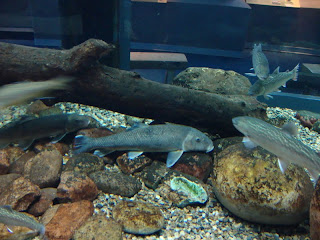The true trouts have black spots on their body, but the chars do not have them. For example, the Rainbow, Cutthroat, and Brown trout are true trouts, but the Bull, Brook, and Lake trout are char./
Las verdaderas truchas tienen puntos negros en su cuerpo, pero las no verdaderas no. Por ejemplo, la trucha arcoiris, Cutthroat, y el Brown son truchas verdaderas, mientras que el Bull, Brook, y Lake no lo son.
Bow Habitat's publication
The White sucker, Catostomus commersoni, could be find it in shallow rivers and lakes of warm water, and it is a bottom feeder which feeds on aquatic invertebrates and insects (Kavanagh, 1991)/
Catostomus commersoni puede ser encontrado en ríos y lagos de agua caliente. Se alimenta de invertebrados acuáticos e insectos que esten cerca del fondo marino.
 |
| Adult White sucker/ White sucker adulto |
The Bull trout, Salvelinus confluentus, is found in cold lakes and streams. Furthermore, it feeds on small fish, larvae, and invertebrates (Kavanagh, 1991)/
La trucha toro, Salvelinus confluentus, se encuentra en lagos y riachuelos de agua fria. Además, se alimenta de peces pequeños, larvas, e invertebrados.
The Brown Trout, Salmo trutta, is found in streams and lakes in southwestern Alberta. Also, it feeds on insects, fish, and crustaceans/
La trucha marrón o común, Salmo trutta, se encuentra en riachuelos y lagos del suroeste de Alberta. Además, se alimenta de insectos, peces, y crustáceos.
The Brook Trout, Salvelinus fontinalis, is found in streams, ponds, and shallow lakes in the mountain region. It feeds on small fish, larvae, and invertebrates (Kavanagh, 1991)/
La trucha de arroyo, Salvelinus fontinalis, se encuentra en riachuelos, charcas, y lagos poco profundos en zonas de montaña.
I hope you like it!








No comments:
Post a Comment